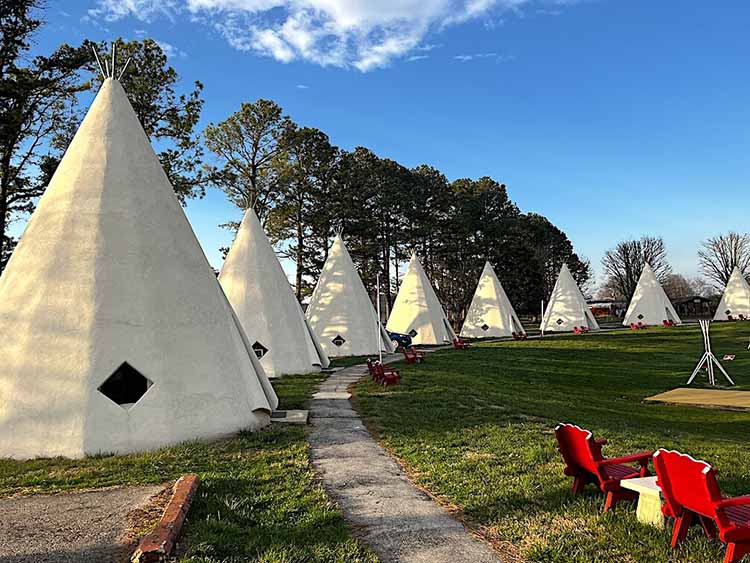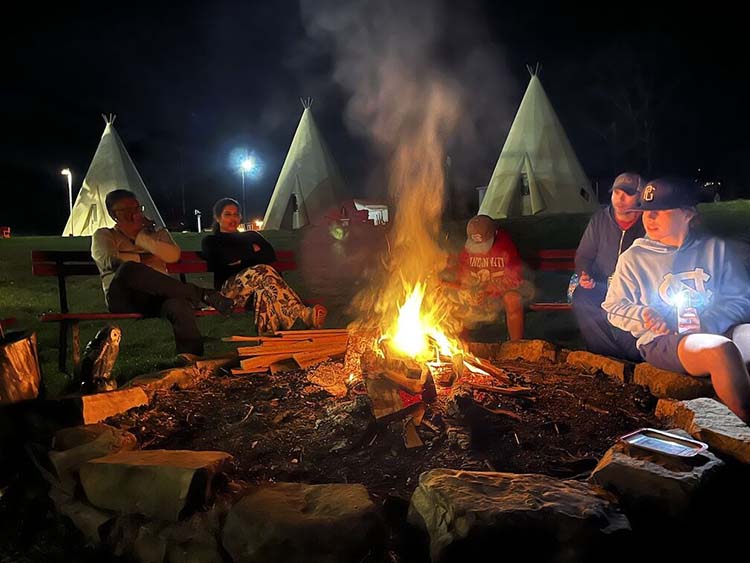
By Tom Adkinson
Jul 18, 2025
 |
|---|
| Wigwam Village creator Frank Redford knew his collection of faux teepees would catch the eyes of early leisure travelers. Image by Tom Adkinson |
CAVE CITY, Ky. – Tent camping in Kentucky’s cave country has a special meaning because of a relic from the early days of
American leisure road travel. Mammoth Cave National Park may be the region’s natural wonder, but Wigwam Village No. 2 takes the
prize as the region’s novel attraction.
 |
|---|
| The interior walls of Wigwam Village rooms do slope inward for your night when you are invited to “Sleep Outside of the Box.” Image by Tom Adkinson |
Wigwam Village No. 2 is a set of 15 teepees along U.S. 31 W. that actually are motel guest rooms. The crown jewel is the 50-foot-tall
Big Wigwam that was a restaurant in the early days of the business, which has operated continuously since 1937. The village has had
its ups and downs over the decades, but it’s on an up right now.
The originator was Kentucky entrepreneur Frank Redford. The teepees – concrete structures, not poles covered with animal hides – were
part of a franchise plan as Americans were beginning to develop the wanderlust of automobile travel. The Wigwam Village concept
predated franchise giants such as Holiday Inn and Howard Johnson, which didn’t come on the scene until the 1950s, and their
rectangular rooms.
 |
|---|
| Owner Keith Stone spends time with every guest to explain the history of Wigwam Village No. 2 and to set the record straight about the region’s true Native American heritage. Image by Tom Adkinson |
Redford opened Wigwam Village No. 1 in nearby Horse Cave in 1933 with a teepee-shaped lunchroom and gas station and added six
teepee motel rooms in 1935. He patented the design in 1936. Five more villages popped up in Alabama, Louisiana, California and
Arizona. Wigwam Village No. 2, Wigwam Village No. 6 in Arizona and Wigwam Village No. 7 in California are the only operating
survivors.
 |
|---|
| The architecture of Wigwam Village No. 2 grabs your attention, but memories come from sitting around a campfire with fellow travelers. Image by Tom Adkinson |
All are on the National Register of Historic Places, and they are so distinctive that their architecture crept into pop culture. If you’ve seen the Disney movie “Cars,” Wigwam Villages inspired the Cozy Cone Motel.
Husband and wife Keith Stone and Megan Smith from Louisville bought Wigwam Village No. 2 in 2021, putting their interests in architecture and historic preservation to work. Their goal: “Restore it to its 1937 splendor.”
Ten of their teepees have one bed, and five have two beds. In front of them is a grassy common area with kids’ games and a campfire circle. The nightly campfire pulls guests out of their rooms for usually travel-oriented conversations as they compare notes about caves to visit and area restaurants to patronize.
The afternoon check-in begins with a casual chat with Stone who explains the history of the unusual lodging and emphasizes that Wigwam Village No. 2 is not a destination to immerse yourself in Native American lore. Although business founder Redford was enamored with Native Americans, he was not shooting for authenticity.
 |
|---|
| Eli Jackson of Madison, Tenn., scores another goal in the playground and campfire area of Wigwam Village No. 2. Image by Tom Adkinson |
Consider the Wigwam Village name itself. The conical structures he designed weren’t wigwams. They are teepees – and neither was the kind of lodging that indigenous people of this region used. Misguided cultural appropriation aside, they were kitsch – and they became a piece of American travel industry history.
Inside, the rooms feature mostly original rustic furniture, modern bathrooms, air-conditioning and Wi-Fi. The sloping interiors can be a challenge if you leap out of bed on the side next to the wall, but it’s all good fun. As Wigwam Village’s slogan says, “Sleep Outside of the Box.”
Trip-planning resources:
HistoricWigwamVillage.com and NPS.gov/maca
(Travel writer Tom Adkinson’s book, 100 Things To Do in Nashville Before You Die, is available at Amazon.com.)
